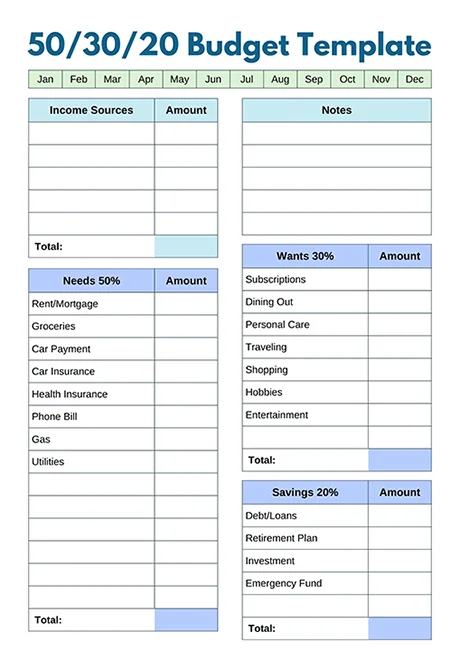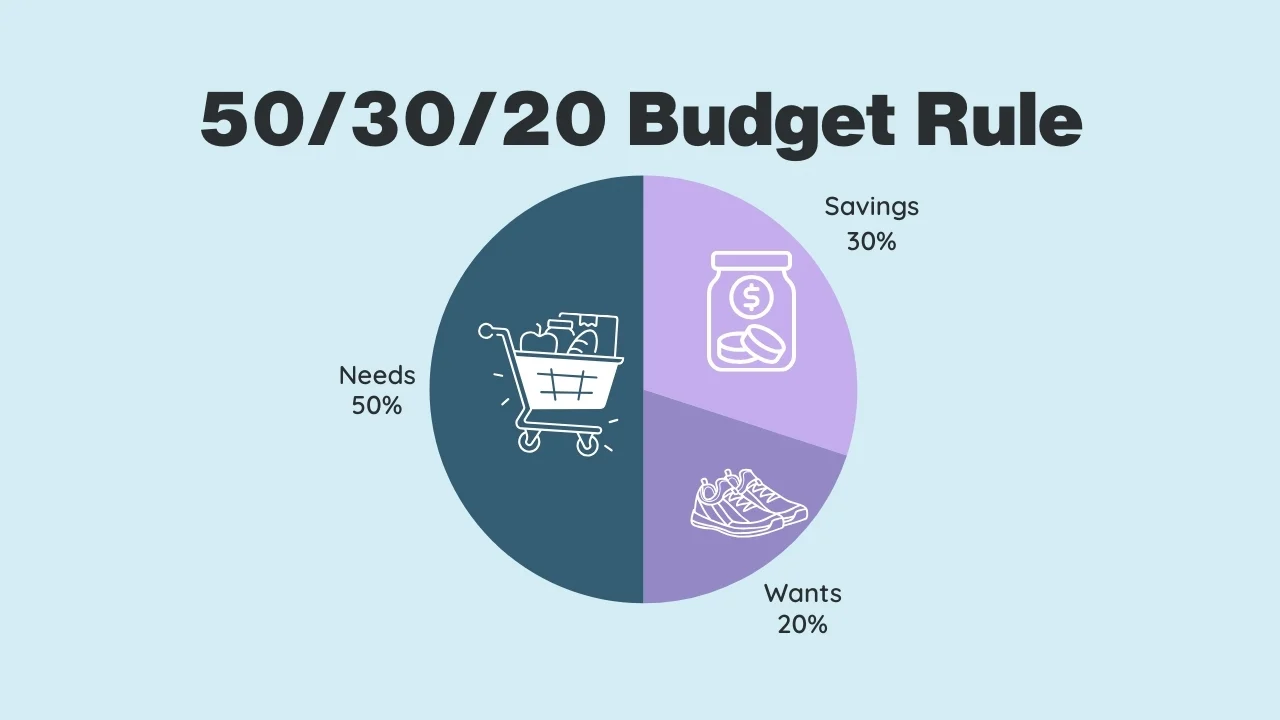Have you heard the name of 50/30/20 budget rule for managing personal finance effectively? It is a simple yet powerful framework that can help you allocate your income wisely and work towards your financial goals.
Feeling overwhelmed by your finances? Struggling to save while still enjoying life’s pleasures? The 50/30/20 budget rule could be your financial lifesaver. This budgeting method provides a clear roadmap for managing your money, helping you balance essential expenses, discretionary spending, and savings goals. By applying the 50/30/20 rule for budgeting you can gain control over your finances, reduce financial stress, and work towards a brighter financial future.
In this article, I explain exactly what the 50/30/20 budget rule is and why it works. Moreover, I have broken down the theory of the 50/30/20 rule for budgeting and how it is implemented. Furthermore, I will address the common challenges you might encounter and offer solutions to help you stay on track. Additionally, I will introduce you to a printable 50/30/20 budget template that you can modify and download for free and keep track of your financial goals. No more words, let’s dive into the article and achieve your financial goals.
What is the 50/30/20 Budget Rule?
The 50/30/20 budget rule is a popular financial guideline that helps you to manage your money simply. It splits your income into three parts: needs, wants, and savings or debt repayment. This helps you live a balanced and financially smart life.
For instance, if you earn $3,000 after taxes, allocate $1,500 for necessities like rent, utilities, and groceries, $900 for wants such as dining out and entertainment, and $600 for savings and debt repayment.
Why the 50/30/20 Rule is Effective
The 50/30/20 rule works well because it makes budgeting clear and balanced. It helps you cover your basic costs, keep your spending on wants in check, and save or pay off debt. This method allows you to see where you’re spending, find ways to save, and make smart money choices.
Of course, having a hold of the 50/30/20 rule is one of the primary keys to financial stability and growth. By using it, you can better manage your money, lower stress, and reach your financial goals.
The Breakdown of 50 30 20 Budget Rule
The 50/30/20 budget rule provides a simple framework for allocating your after-tax income into three main categories:
50% for Needs: Essential Expenses
This portion of your income is dedicated to covering essential expenses that are necessary for survival and maintaining your lifestyle. These expenses are things like rent, utilities, food, and car costs. These include:
- Housing: Rent or mortgage payments, property taxes, homeowners insurance
- Utilities: Electricity, gas, water, internet, and phone bills
- Groceries: Food and household supplies
- Transportation: Car payments, fuel, public transportation, car insurance
Watching your essential expenses closely and following the 50/30/20 rule helps you balance your spending. This method is good for your financial health and sets you up for success in managing your money.
30% for Wants: Discretionary Spending
This category covers expenses that are not essential like eating out, fun activities, travel, and hobbies, but enhance your quality of life. It’s important to balance your needs and wants for good budgeting and financial planning. Some examples include:
- Dining out: Restaurants, cafes, and takeout
- Entertainment: Movies, concerts, subscriptions, hobbies
- Shopping: Clothing, accessories, electronics
- Vacations: Travel, accommodations, and activities
- Personal care: Gym memberships, haircuts, beauty products
Finding the right balance between needs and wants lets you live well and stick to your 50/30/20 budget. This way, you can reach your financial goals.
20% for Savings and Debt Repayment
The “20%” part of the 50 30 20 budget rule is for saving and paying off debt. It’s a key way to build financial security. The more you can save in this part, the more secure the future. It includes:
- Emergency fund: Saving for unexpected expenses
- Debt repayment: Credit card balances, student loans, personal loans
- Retirement savings: 401(k), IRA, or other investment accounts
- Other financial goals: Down payment for a house, education savings, or major purchases
Saving and paying off debt are key to good money management. Using 20% of your income for these means is a smart move. By setting aside 20% for savings and debt, you are taking charge of your financial future. This is how you create a stable and prosperous life.
How to Implement the 50/30/20 Rule for Budgeting
The secret recipe of success behind how well you follow through on the formula. Here’s a step-by-step guide to make budgeting easier with the 50/30/20 rule.
- Calculate Your After-Tax Income: Calculate your income per month or annum after deducting taxes and other deductions.
- Track your spending: It means keeping track of your expenses for a few months so that you can understand your spending habits.
- Allocate Your Income: Divide your income between the three categories in this ratio: 50/30/20.
- Create a Budget: Develop a detailed budget outlining your income and expenses.
- Review and adjust: Look over your budget regularly and accordingly adjust the money spent.
50/30/20 Budget Rule for Different Income Levels
The 50/30/20 rule is a common formula that high-income earners can easily adapt. However, it would be a little bit challenging for low-income households. They may need small adjustments to the basic formula. Let’s how different income levels households can adapt to the 50-30-20 budget rule.
Adapting the 50/30/20 Rule for Low-Income Households
The 50/30/20 rule needs some tweaking when dealing with low-income groups. They may use a 60/20/20 or even 70/20/10 budget rule. This way, they cover basic needs but still save and pay off debts.
Applying the 50/30/20 Rule for High-Income Earners
A high-income earner will have a wide scope to save more or spend more. They can adjust the percentages to fit their financial goals and lifestyle. They may use 40/40/20, or even a 45/35/20 rule which puts more into saving and fun spending.
Common Challenges and Solutions
While the 50/30/20 rule makes a good formula, it may not be suitable for everyone or every financial situation. Some common challenges include:
- Overspending in the “wants” category: Set spending limits, use cash instead of cards, and find free or low-cost alternatives.
- Unexpected expenses: Build an emergency fund to shield against unexpected incidences and adjust the budget accordingly.
- Low income: Prioritize needs and cut back on non-essential expenses. Government assistance programs should be considered if one is eligible.
- High debt: Focus on paying off those with the highest interest rates first and create a debt repayment plan.
Flexibility and adaptability are the keys to overcoming these challenges. Keep changing your budget to maintain financial stability whenever needed.
Get 50/30/20 Budget Template Free

Good news for those who stick to following the budgeting rule. I have created a printable 50/30/20 budget template for your convenience. You can modify this template and download it to keep track of your initiative.

Get Access Printable 50/30/20 Budget Template Free!
To get on track to financial freedom grab our free budget template today.
How to Use 50/30/20 Budget Rule Template
The process of using the 50/30/20 budget template is easy.
Click on the link given above and download it by clicking on Share button.
Then click on the Download button and choose file type. (by default, PDF standard file will be downloaded). However, if you want you can change the file format to JPG, PNG, SVG.

Moreover, if you want to change the font, text, or color; you can easily do it and then can download your customized budget template.
Download 50/30/20 Budget Rule Template pdf File Free
Final Thoughts
The 50/30/20 budgeting rule is a helpful technique to manage money. By following this simple framework and making smart choices about spending, you can achieve financial freedom and build a secure future. Keep in mind that budgeting is an ongoing task, so make sure to regularly check and change your plan to match your changing financial goals.


Leave a Reply